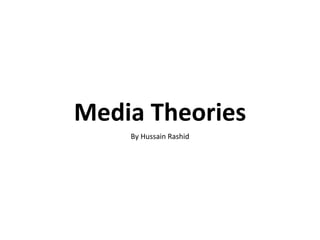
Narrative Theories
- 1. Media Theories By Hussain Rashid
- 2. Tzvetan Todorov Bulgarian Structuralist/Philosopher publishing work on narrative from the 1960’s onwards. He believed all stories began with an ‘equilibrium’ where any potential opposing forces are in balance. This is disrupted by some event, setting in motion a series of other events. Problems are solved so that order can be restored to close with a second but different ‘equilibrium’ or status quo. Equilibrium – Disruption of Equilibrium – Reordered Equilibrium
- 4. Propp’s character types remind us that though characters may seem very ‘real’ they must be understood as constructed characters. In films, characters are played by actors who are chosen to (or made to through use of costume and make up) resemble perceptions of their characters. They have roles to play for the sake of the story and are often perceived very quickly, if unconsciously by audiences in these roles as ‘hero’, ‘villain’ etc. The character roles and the functions identified by the Propp can be applied to all kinds of narrative. In TV news programmes we are often presented with “heroes” and “villains”.
- 5. A story analyst for various Hollywood film companies, Vogler’s definition of character archetypes and the 12 ‘stages’ of the hero’s journey has become very influential in Hollywood. Vogler’s 12 stages of the hero’s journey: Chris Vogler
- 6. Claude Levi-Strauss After studying hundreds of myths and legends from around the world, Levi-Strauss observed that we make sense of the world, people and events through understanding of binary oppositions. Binary oppositions are sets of opposite values, for example GOOD and EVIL – we understand the concept of good as being the opposite of evil. Levi-Strauss was not so interested in the order in which events were arranged in the in the plot, instead he looked for deeper arrangements of themes. He observed that all the narratives are organised around the conflict between binary opposites. Examples:
- 7. Roland Barthes French literary theorist, philosopher and semiotician, Barthes suggested that narrative works with five different codes, The Enigma code, The Action code, The Semantic Code, The Symbolic Code and The Cultural Code. The Enigma Code refers to any element of the story that is not fully explained and hence becomes a mystery to the reader. Most stories hold back details in order to increase the effect of the final revelation of all the truths. We tend not to be satisfied by a narrative unless all ‘loose ends’ are tied; however, narratives often frustrate the early revelation of truths by offering: Snares - deliberately avoiding the truth Vagueness – partial or incomplete answers Jammings – openly acknowledge that there is no answer to a problem A great example of something that contains the enigma code is the genre of a detective story.
- 8. The Action Code also builds tension, referring to any other action or event that indicates that something else is going to happen and which hence gets the reader guessing as to what will happen next. The Enigma and Action Codes work as a pair to develop the stories tensions and keep the reader interested. The Semantic Code this code refers to connotation within the text that gives additional meaning over the basic denotative meaning of the story. The Symbolic Code This is very similar to the Semantic Code but acts at a wider ;eve;, organising Semantic meanings into broader and deeper sets of meaning. This is typically done in the use of antithesis, where new meaning arises out of opposing and conflicting ideas. The Cultural Code this code refers to anything that is founded on some kind of canonical works that cannot be challenged and is assumed to be a foundation for truth. It tries to explore not just how the narrative works ‘internally’ but also how it evokes connections to the world outside the text for the reader (i.e. cultural references etc) in other words, the cultural codes tend to point to our shared knowledge about the way the world works